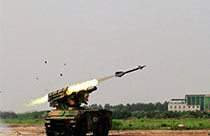

V. Improving People's Welfare
Under the system of regional ethnic autonomy, Tibet's economic and social development has achieved leapfrog development by constantly reaching higher levels. Rapid economic growth and comprehensive social progress have brought real benefits to all ethnic groups in Tibet, effectively guaranteeing their right to subsistence and development, and maintaining the harmony and stability of its society.
-Tibet's modernization level has steadily risen.
Tibet's GDP soared from 327 million yuan in 1965 to 92.08 billion yuan in 2014, a 281-fold increase. Since 1994, the local GDP has grown at an annual rate of 12.4 percent on average, registering double-digit growth for 20 consecutive years. Local fiscal revenues increased from 22.39 million yuan in 1965 to 16.475 billion yuan in 2014, an average annual increase of 14.46 percent, further enhancing Tibet's self-development capabilities. The Region's industrial added value skyrocketed from nine million yuan in 1965 to 6.616 billion yuan in 2014, a 735-fold increase, or an average annual growth of 14.4 percent, and the proportion of secondary industry's added value in the local GDP rose from 6.7 percent in 1965 to 36.6 percent in 2014. Total retail sales of consumer goods increased from 89 million yuan in 1965 to 36.451 billion yuan in 2014, a 409-fold increase, or an average annual growth of 13.1 percent. The total volume of Tibet's foreign trade rose from US$7 million in 1965 to US$2.255 billion in 2014, a 321-fold increase, or an average annual growth of 12.5 percent.
Priority has been given to such industries with Tibetan characteristics as Tibetan medicine, folk handicrafts, green food and drinks, and new energy. At present, seven industrial belts have taken shape, 20 demonstration zones of standardized agriculture have been established, and 95 agricultural and animal husbandry industrialization leading enterprises at or above the prefectural level cultivated. Nine big groups have been established, one by one, including construction and engineering, mining, tourism, Tibetan medicine, and commerce and trade. Tibetan medicine industry has taken shape, with 18 pharmaceutical enterprises producing more than 360 kinds of drugs. The output of natural drinking water has exceeded 300,000 tons, making the industry a new economic growth point. In 2014, Tibet received 15.53 million tourists, a 4,436-fold increase compared with 1980 when the Region first opened to tourism, or an average annual increase of 28 percent. Tourism revenue has now reached 20.4 billion yuan, a 20,400-fold increase or an average annual increase of 32.8 percent.
A comprehensive transportation system including roads, railways and aviation has been built, further facilitating Tibet's transportation. Radiating from Lhasa to Sichuan and Yunnan in the east, Xinjiang in the west, Qinghai in the north, and India and Nepal in the south, a road transportation network that connects prefectures, cities, counties, and townships has taken shape. At the end of 2014, the total length of roads open to traffic reached 75,000 km, 8,891 km of which have sub-high-grade surfaces or better, accounting for 12.6 percent of the total. Sixty-five, or 88 percent, of all 74 counties in Tibet had access to asphalt roads. As many as 690 townships and 5,408 administrative villages could be reached by road, respectively accounting for 99.7 percent and 99.2 percent of the total. The Golmud-Lhasa and Lhasa-Shigatse railways had opened to traffic, and the construction of the railway connecting Lhasa and Nyingchi started. Tibet Airlines was established, with five airports, and eight airlines operating in Tibet. An airport network has taken shape in Tibet, with Gongkar Airport in Lhasa as the main hub, and Bangda Airport in Qamdo, Menling Airport in Nyingchi, Gunsa Airport in Ngari and Heping Airport in Shigatse as the branches, catering to 48 domestic and international air routes that link Tibet with 33 cities in China and the rest of the world.
An extensive energy system has now been formed with hydropower as the mainstay, backed up by geothermal, wind, and solar energy sources. Lhasa's Ethernet ring network project and power transmission and transformation project, the Qinghai-Tibet Power Grid Interconnection Project, and the Sichuan-Tibet Interconnection Project have officially gone into operation, so consigning to history the previously solitary operation of Tibet Autonomous Region power line. Such emergency power supply projects as Zhikong Hydropower Station, Shiquanhe Hydropower Station, Xueka Hydropower Station, Yangbajain Geothermal Power Station, and Lhasa's thermal power plant have been built and put into operation. Zam Hydropower Station, the hydroelectric project with the biggest installed capacity in the Region, has also become operational. Moreover, the building of energy bases was facilitated. In 2014 the total installed generating capacity reached 1.697 million kw, and the annual output of generated electricity came to 3.22 billion kwh. Tibet initiated and carried out power construction projects in Nyima County and Tsonyi in Nagchu, and in seven counties and one township in Ngari that were without electricity. The Region has demonstrated and promoted 30,000 photovoltaic (PV) systems, established 90 PV power plants, and more than 1,200 solar streetlamps, with a total installed capacity of 8,000 kw. By the end of 2012, all administrative villages had access to electricity, and the problem of electricity access had been basically solved.
Tibet has now entered the information age, having established a modern telecommunications network with optical cable satellites and the Internet as the backbone. The total length of optical cable lines in the Region has reached 97,000 km, among which over 30,000 km are long-distance optical cable lines. Optical cables have now reached 668 townships and towns in 74 counties, or 97.8 percent of all townships and towns in Tibet, and mobile phone signals cover 5,261 administrative villages. The number of Internet user households has reached 2.177 million, with an Internet penetration of 70.7 percent, and mobile Internet coverage in farming and pastoral areas has surpassed 65 percent.
-People's happiness quotient has been greatly improved.
People in both urban and rural areas are living a richer and fuller life as their incomes increase rapidly. In 2014 the per capita disposable income of urban residents reached 22,016 yuan, a 38-fold increase, or an average annual increase of 10.7 percent compared with 565 yuan in 1978; and that of farmers and herdsmen was 7,359 yuan, representing an average annual increase of 10.9 percent. The level of urbanization has also steadily risen. The proportion of urban population during the third population census in 1982 was 9.48 percent, but this percentage increased to 11.52 in 1990, to 19.43 in 2000 and to 22.67 in 2010. Along with improvements to the people's livelihood, diversified consumption patterns have appeared, and such consumer goods as refrigerators, color TV sets, computers, washing machines, motorcycles, and mobile phones have entered ordinary households. Many farmers and herdsmen have become well-off and built new houses; some have even bought automobiles. Radio, television, telecommunications, the Internet and other modern information transmission means, which are at the same level as that of the country and the rest of the world, are now part of Tibetans' daily life. According to the "CCTV Economic Life Survey" jointly hosted by the National Bureau of Statistics, China Post Group, and China Central Television (CCTV), Lhasa has topped the "happiness index" in China for five consecutive years.
Both urban and rural residents' living conditions have greatly improved. Tibet took the lead in 2006 in initiating low-income housing projects for local farmers and herdsmen. By the end of 2013, the Region had appropriated 27.8 billion yuan and finished building 460,300 low-income houses. As many as 2.3 million farmers and herdsmen had moved into safe modern houses, their per capita living space having reached 30.4 sq m, so marking an historic improvement in their living conditions. Constantly increasing input into the building of relocation housing, Tibet has built 66,076 more such houses covering 4.0442 million sq m, with an input of 8.809 billion yuan. The Region has proactively carried out the city heating project in Lhasa. Since initiation of the project in 2012, Tibet has built 63 km of a main gas pipe network, 256 km of a secondary pipe network and more than 1,200 km of a courtyard pipe network. It has completed 768 heating projects for residential areas and workplaces, so benefiting 107,000 households in a 21.36 million sq m area. The heating system has become available to almost all urban areas in Lhasa. The burning of dung for heating is now history.
Farmers and herdsmen are living in a clean and beautiful environment. Tibet has also improved its facilities in the areas of water, electricity, highways, gas, telecommunications, postal services, radio and television, and the environment in farming and pastoral areas, basically solving the problem of drinking water safety. It has also realized telephone communication and radio and TV coverage in all villages, and broadband connection in all townships. Tibet has improved the living environment of 4,500 administrative villages. Almost 240,000 farmer and herdsman households use clean biogas, and more than 95 percent of rural households cook with iodized salt. Since 2010, work on improving the people's living environment and the ecological environment has been carried out in Tibet according to the requirement of "clean water, clean farm and clean home." At present programs for improving the appearance of villages and the ecological environment have been carried out in 4,500 administrative villages with an input of 4.4 billion yuan.
The poverty-stricken population has been substantially reduced. From 2006 to 2014, Tibet launched the "Campaign to Develop Border Areas and Improve the Lives of the People," relocated poverty-stricken families and people with Kashin-Beck disease, and increased by 20 to 30 percent the per capita living area of 116,300 poverty-stricken families. Many people have moved from small, dark, adobe houses, where they lived alongside livestock, to safe, more suitable homes. Poverty relief projects have benefited 2.6 million people in 578,000 households. Tibet has built and renovated a total of 3,223 km of country roads, 3,371.6 km of irrigation channels, 347 ponds covering a total 2.3294 million sq m; it has built 883 bridges for agricultural purposes of a total 12,834 m in length, 4,583 greenhouses, and 35,000 pens. It has also installed or improved irrigation systems for 300,000 mu (one mu = 1/15 hectare) of farmland. Tibet has moreover improved the ecological environment of poverty-stricken areas, and the total area of fenced grassland, improved grassland, and planted grassland has reached 287,800 mu. Since 2003, the income of farmers and herdsmen has recorded double-digit growth for 12 consecutive years. The poverty-stricken population - people with a per capita per annum income of less than 2,300 yuan (at constant price of 2010) - has fallen from 1.17 million in 2010 to 610,000 at the end of 2014. The proportion of poverty-stricken population in the Region's total population of farmers and herdsmen fell from 49.2 percent in 2010 to 23.7 percent in 2014. Since 2006, the Region has directly or indirectly allocated a total of 70.636 billion yuan in subsidies to strengthening agriculture and benefiting farmers, 189 million yuan in subsidies to grain production, 358 million yuan as general subsidies for purchasing agricultural supplies, and 340 million yuan as subsidies for purchasing home appliances and furniture. Those subsidies have increased the income and purchasing power of farmers and herdsmen and improved their living standards.
Tibet's social security has entered a new stage. Due to its proactive employment policy, Tibet has maintained a high employment rate. In 2014 the registered urban unemployment rate was maintained at below 2.5 percent, and newly increased urban employment totaled 43,000. Graduates from institutions of higher learning were provided with 11,000 jobs in the public sector, while provinces, municipalities directly under the central government and centrally managed state-owned enterprises offered 5,335 job vacancies. More than 1,500 graduates from Tibet found jobs in other parts of the country. The number of public welfare jobs in the Region totaled 30,000, and 26,018 people found jobs in public welfare sectors. More than 2,500 zero-employment households were provided with jobs in a timely manner, and the employment situation remained stable. In recent years, the social security system that covers both urban and rural residents has been established in an all-round way. Tibet strengthened the security system of "five major insurance types" (endowment insurance, unemployment insurance, work-related injury insurance, medical insurance, and maternity insurance), improved the social endowment insurance system for urban and rural residents, expanded the basic living allowance, implemented free accident insurance, and established the basic endowment insurance and medical insurance systems for monks and nuns. These moves have benefited 2.606 million insurance participants. The basic old-age pension for enterprise retirees in Tibet reached 3,338 yuan per person per month, one of the highest in the country. The basic living allowance for urban residents was raised to 534 yuan per person per month and to 2,231 yuan for rural residents per person per year. The yearly payment to those who enjoy the "five guarantees" (for food, clothing, medical care, housing and funeral expenses) was significantly raised to 3,873 yuan per person per year, the standard of rural decentralized support rose to 3,874 yuan per person per year, and the minimum subsistence guarantees for children housed in orphanages was 1,200 yuan per person per month. Condolence money was also timely extended to impoverished urban and rural residents. By the end of 2013, there were 263 social welfare organizations, eight state-run children's welfare homes, and two private children's welfare homes in Tibet. Centralized support covered 72 percent of those who enjoy the "five guarantees," and more than 5,900 orphans were effectively supported.
Tibet's medical undertakings are also rapidly improving. A medical and health network that integrates traditional Chinese, Western and Tibetan medicines has been established in Tibet, covering all cities and villages in the Region, with Lhasa as the center. The Region has built 71 county hospitals and 678 township clinics that provide free basic medical services to all farmers and herdsmen. The medical service system that covers all urban and rural areas is improving, and a three-tier medical service network that covers counties, townships and villages is in place. By the end of 2014, there were 1,430 medical organizations in Tibet, and 3.79 hospital beds and 4.08 medical workers for every 1,000 residents. Maximum payment of basic medical insurance for urban employees reached 300,000 yuan, and for urban residents 200,000 yuan. The fiscal subsidy standard for urban residents' basic medical insurance increased to 380 yuan per person every year, and the inpatient reimbursement rate for urban residents covered by the medical insurance policy reached 75 percent. All farmers and herdsmen in Tibet are now covered by a medical system based on free medical service. It provides each farmer and herdsman with an annual medical allowance of 420 yuan, and an 80 percent reimbursement rate for medical services that the policy covers, with a maximum medical reimbursement of 60,000 yuan. All monks and nuns are included in the basic medical insurance system. Tibet has abolished the deductible line of medical assistance, and was among the earliest in China to realize full coverage and urban-rural integration of medical assistance. Tibet also provides free physical examinations for urban and rural residents, and 99 percent of the Region's urban and rural residents have health records. In 2013, the childbirth mortality rate had fallen to 1.5451 per thousand and the infant mortality rate to 19.97 per thousand. Average life expectancy has risen from 35.5 years in the 1950s to the present 68.17 years. The Region has basically stamped out diseases caused by iodine deficiency.
- Progress has been made in all social undertakings.
Tibet's education has taken on a new look, and all children can now go to school. Nine-year compulsory education is practiced in all counties in the Region, and a complete modern education system is in place, covering preschool education, basic education, vocational education, higher education, adult education, and special education. Tibet has realized 15-year free education from the preschool stage to senior middle school, fully implemented the nutrition improvement plan for students under compulsory education in agricultural and pastoral areas, and realized 100 percent coverage in terms of both policies and funds. Tibet has covered all tuition, food, and boarding expenses for students from farmers' and herdsmen's families and those from families in urban areas with financial difficulties from preschool education to senior middle school education, and raised the subsidy standard many times to today's 3,000 yuan per student every year. Tibet has launched the campaign to provide three-year bilingual education for preschool children in urban areas, and two years for those in agricultural and pastoral areas. At the end of 2014, there were more than 80,000 children in kindergartens, and the gross enrollment rate for preschool education had reached 60 percent; there were six higher education institutions, nine secondary vocational schools with 17,000 students, 22 senior middle schools, four six-year middle schools, 93 junior middle schools, three nine-year education schools, three 12-year education schools, and 829 primary schools. The primary school enrollment rate reached 99.64 percent among school-age children, the illiteracy rate among young and middle-aged people fell to less than 0.57 percent, and the average length of education reached 8.6 years for the Region's general population and above 12 years for the newly-increased working population. Since the central government adopted the strategy in 1984 of "cultivating talent for Tibet in other parts of China," Tibetan schools and classes in 21 provinces and municipalities directly under the central government have cultivated more than 32,000 graduates from junior colleges and secondary technical schools for Tibet. Tibet has now cultivated its own postgraduate and Ph.D. students, built almost 30 scientific research institutions, compiled a group of renowned experts and scholars, and an army of 69,709 professionals in such areas as history, economics, demographics, languages, religion, agriculture, animal husbandry, forestry, ecology, biology, Tibetan medicine, salt lakes, and geothermal and solar energy. Tibet tops China in areas such as Tibetan studies, plateau ecology, and Tibetan medicine, and boasts academic achievements of world influence.
Public cultural services now cover both urban and rural areas in Tibet, and have enriched people's cultural life. The Region has built eight public art centers, five public libraries, three museums, 74 county-level cultural activity centers, and 692 township-level cultural stations. In addition, it has built one regional center, seven prefecture-level sub-centers, 74 county-level sub-centers, 692 township-level stations, and 5,389 village-level stations as part of the project to share cultural information and resources. A cultural facility network covering the four levels of autonomous region, prefecture, county, and township is also taking shape. The cultural facility construction project as an important part of the 12th Five-year Plan (2011-2015) with a total input of nearly 1.3 billion yuan is making full progress. By the end of 2015, all prefectures and cities in Tibet will have public libraries and cultural centers, areas rich in cultural relics will have museums, all counties will have libraries, cultural centers or comprehensive cultural activity centers, all townships will have cultural stations, and 53 percent of the county-level state-owned art troupes will have rehearsal spaces. The total number of public cultural venues will reach 790. Tibet has built more than 1,600 cultural squares, and launched 90 regularly-staged popular cultural activities, including the Lhasa Shoton Festival celebrations. Tibet also initiated the campaign to provide free access to public facilities. In the recent five years, the Region's public cultural venues have launched more than 40,000 free mass cultural events, benefiting more than eight million people. The Region's professional art groups and folk art groups at the county level staged more than 10,000 shows, and sent more than 100,000 books to the countryside.
Tibet's press and publishing are growing fast, and more and more cultural products are appearing. Tibet People's Publishing House and Tibetan Ancient Books Publishing House published 19,052 book and textbook titles, totaling 282.63 million printed copies. In 2014, the Tibet Audio-Visual Publishing House and the Snowfield Electronic Audio-Visual Publishing House published 115 audio-visual and electronic book titles, totaling 379,600 copies. Tibet has 25 newspapers, 35 periodicals, and 576 publishing and distribution entities, among which 89 are Xinhua Bookstores at regional, prefectural and county levels, five are Xinhua Bookstores at frontier ports, and 482 are private distribution networks. In 2014, the autonomous region distributed 33.95 million copies of books, with a total value of 323 million yuan. The Region has 38 printing enterprises, one of which is a key enterprise with its turnover over 20 million yuan per annum. In 2014, the total output of the Region's printing industry reached 360 million yuan. The Region has built 5,609 rural libraries and 1,700 monastery libraries, bringing libraries to all administrative villages and monasteries, and providing all farmers, herdsmen, monks and nuns with access to books.
Tibet's radio, film and television undertakings have also made significant headway. The Region has built, rebuilt or expanded 78 FM stations above 100 w, 78 television transmitters above 50 w, 27 medium wave broadcast transmitters, one satellite earth station, and 9,371 radio and television stations for all villages. All 1,787 monasteries in the Region now have radio, film and television coverage. At present, Tibet has one provincial broadcast station with five frequencies, and its audiences are found in 50 countries and regions. It has one provincial TV station with four channels. Its programs, all digitized, cover more than 700 million people in China, and its satellite TV programs in Tibetan language can be viewed in neighboring Nepal, India, and Bhutan. Tibet has six prefectural-level radio stations, and one TV station. The coverage of radio in Tibet has increased from 12 percent in 1965 to today's 94.78 percent and that of television from zero in 1965 to today's 95.91 percent. More than 90 percent of farmer and herdsman families have access to radio and television. Through direct broadcast satellite receivers, each rural family can receive 40 to 70 digital radio and TV program channels. At present, Tibet has 566 film agencies, including 478 digitized film projection teams in the countryside.
 |  |
 'Enemy planes' intercepted by Hongqi-7B air-defense missiles
'Enemy planes' intercepted by Hongqi-7B air-defense missiles Blind date with bikini girls in Nanjing
Blind date with bikini girls in Nanjing Amazing photos of Chinese fighter jets
Amazing photos of Chinese fighter jets Chinese soldiers participate in training for V-Day parade
Chinese soldiers participate in training for V-Day parade Painting: Lonely women in Forbidden City
Painting: Lonely women in Forbidden City China and Russia hold joint drill in Sea of Japan
China and Russia hold joint drill in Sea of Japan 'Goddess' in Taiwan McDonald's
'Goddess' in Taiwan McDonald's Female soldiers at military parades
Female soldiers at military parades Photos of campus belle doing splits go viral
Photos of campus belle doing splits go viral Best blade forward
Best blade forward Infographic: Parsing China's massive V-day parade
Infographic: Parsing China's massive V-day parade Giant panda cub receives medical care in Guangzhou
Giant panda cub receives medical care in Guangzhou China celebrates 70th Anniversary of Victory of World Anti-Fascist War
China celebrates 70th Anniversary of Victory of World Anti-Fascist WarDay|Week